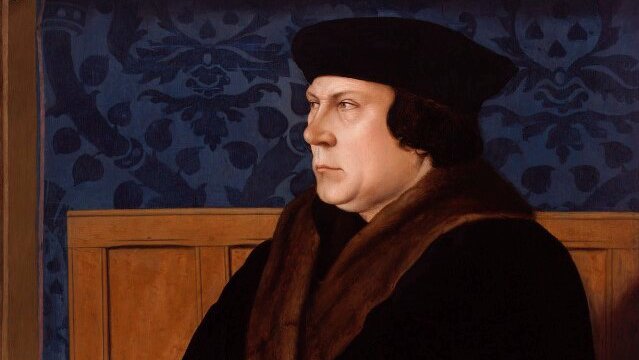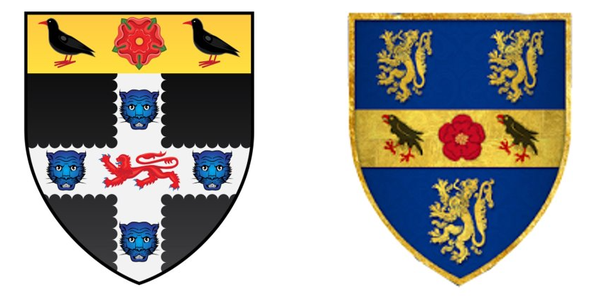10-Minute Talks: Making the real Thomas Cromwell stand up
by Revd Professor Diarmaid MacCulloch Kt FBA
22 Apr 2020

Subscribe to this podcast via your chosen service
Revd Professor Diarmaid MacCulloch Kt FBA talks about how to understand Thomas Cromwell, even though so many of Cromwell's own letters have vanished from his vast surviving archive.
Transcript
Hello my name is Diarmaid MacCulloch. I'm a Fellow of the British Academy, which is the UK's national body for humanities and social sciences, and today I wanted to help you to make the real Thomas Cromwell stand up, in just 10 minutes.
I've devoted my academic career to Tudor England. You can't help meeting Thomas Cromwell pretty quickly then. My old doctoral supervisor helped, because he was Sir Geoffrey Elton and he was frankly rather obsessed by Thomas Cromwell. As I came to the end of my own active academic career, I thought what a perfect book it would be to write a biography of Thomas Cromwell. And as I researched and wrote, I discovered someone else's writing about Thomas Cromwell: Hilary Mantel, writing what are now three brilliant novels on the subject of this great Tudor statesman. We kept in touch once we realised we were both writing. I have to tell you that what you find in her novels is something really rather like the real Thomas Cromwell. But we're doing different things. I'm historian, she's a novelist.
But what do I find when I look at Thomas Cromwell? Well, for one thing I have to deal with the archive, which is huge, thousands on thousands of letters. As you go into it, and I went through them all, I discovered something really rather odd about it. It's all the stuff which came in, what we might call in email terms the "inbox", and what was going out – what you might call the "sent mail" – it's just not there. So you've got thousands and thousands of letters from outsiders to Thomas Cromwell and nothing (virtually – 300 or so and other people's archives) of his letters out.
Why is that? You might say well, it's natural. You keep the letters coming, you don't keep the going out. No, not so with a Tudor archive. Something's gone missing. Thousands on thousands of his letters have gone missing. I think that what happened was that when he was arrested, his household, hearing of his arrest sat up all night burning that sent mail and so we just haven't got it. What they wanted to do, of course, was to save him, because what you write to other people is going to incriminate you, rather than what they write to you. Good try – didn't work. But it's changed the nature of the archive and I had to deal with that, as did Hilary Mantel. How do you get to the real Thomas Cromwell when you can't hear his voice? You can hear him reflected in the voices of other people, but you can't get the man.
How do you get to the real Thomas Cromwell when you can't hear his voice? You can hear him reflected in the voices of other people, but you can't get the man.
That was a real problem, and I had to do various what you might call oblique things in order to meet the real Thomas Cromwell. One thing I did was actually look at his portrait, the famous Holbein picture – and frankly, it's not a very flattering picture. It's a puffy bureaucrat within a minute of losing his temper and yet, the interesting thing about that portrait was that it hung on his own parlour wall. He was prepared to live with that unflattering picture and I rather liked that. It reminded me of something I recorded about his collateral descendant Oliver Cromwell, who famously said to the portraitist Sir Peter Lely, "paint me warts and all". It was if that was a family joke in the Cromwell family. What this told me was here was a man at ease in his own skin. That was rather engaging. And then I looked at something else, which wasn't exactly a document: his coat of arms. Coats of arms matter tremendously in the 16th-century. Heraldry – we've still got it, but frankly it's a bit of an antiquarian, pleasant pursuit these days. Not so in the 16th century. Heraldry was the language of power and what you put on your shield, your coat of arms, really mattered. It had messages. It was important to read those messages right, rather as we have to read road signs right, because something rather unpleasant happens to us if we misunderstand them.

Now what did his heraldry say? What it said was, "I am Cardinal Wolsey’s man". Cardinal Thomas Wolsey was Cromwell's first great employer before his service with King Henry VIII. This heraldry was not actually registered with the College of Arms during Wolsey's lifetime. It was registered two years after, when Cromwell had entered the King's service. That's extraordinary. By that time Wolsey was the yesterday's man, in disgrace, and yet Thomas Cromwell still proclaimed his allegiance to Wolsey.
I thought that was very interesting and unexpected, because it would have annoyed two people of huge significance in the Tudor Court. One of them was Thomas Howard, 4th Duke of Norfolk, who was his enemy, and the other was the niece of the Duke of Norfolk, Anne Boleyn. Queen Anne Boleyn, as she was going to become. Now, there was a symbol that this rising politician, statesmen, alongside the Queen, was actually the man who was the servant of Wolsey, whom effectively Anne Boleyn had destroyed. She must have been furious. It went against the common story of the relations between Anne Boleyn and Thomas Cromwell, because they've always been seen as allies right from the 16th century. In fact, no – they hated each other, they loathed each other. She obstructed his career with the King. It became quite obvious as I went through the papers that his career had stalled while Queen Anne was on the throne. Then she was executed. That made sense of something else.
It was quite clear that Thomas Cromwell had been at the heart of her execution and that's always puzzled historians. If these people were allies, how could he turn against her? Is that just treachery? No. They always loathed each other, and his career took off after her death. And also that brought another relationship with it. If Cromwell and Anne loathed each other, then that would be very much in the interest of another great lady at court: the Lady Mary, daughter of the previous Queen, Catherine of Aragon. Now there was something unexpected, because it became obvious as I looked through the papers that Mary was the ally of Thomas Cromwell. In fact, in the end, she became godmother to his first grandson. An unexpected relationship.
So the fascination with the man grew and grew. All sorts of unexpected relationships leapt out at me.
The foundation of his career was his service with Cardinal Wolsey. What was that service about? Cromwell was nothing when he entered the Cardinal service and yet, out of all the jobbing lawyers and moneylenders in London, Wolsey took him up – why? I delved back to Thomas Cromwell's very odd early career, he ended up in Italy. An obscure boy from Putney, he went to the centre of civilisation in Europe and he came back mysteriously well-educated. Fluent in Italian, in German and Latin, but that Italian was what was important. When he entered Cardinal Wolsey's service he was there for a very specific purpose. To deal with the Italian craftsmen making the Cardinal’s tomb. And around the Cardinal’s tomb were a fleet of clergy to pray for the Cardinal’s soul, organised into collegia – a fleet of clergy colleges. Colleges of clergy. Wolsey founded two colleges: one in Ipswich, his hometown; one in Oxford, his university base before he was a great man. And now those two colleges would be organised by Thomas Cromwell and they'd be financed by the money from little monasteries which the Cardinal dissolved.
Hey presto! There was an explanation for how Thomas Cromwell, the obscure boy from Putney, entered the service of the second greatest man in the realm and went on into the service of the greatest man, King Henry VIII. Well, those are just a few of the things I discovered. Maybe if you read my biography you'll discover more. But of course, you could do what historians do, and research for yourselves.
This talk originally took place on 22 April 2020, part of the series The British Academy 10-Minute Talks, where the world’s leading professors explain the latest thinking in the humanities and social sciences in just 10 minutes. 10-Minute Talks are screened each Wednesday, 13:00-13:10, on YouTube and available on Apple Podcasts. Subscribe to the British Academy 10-Minute Talks here.
Further reading
Thomas Cromwell: A Life, Diarmaid MacCulloch.
England Under the Tudors, G.R. Elton.
"The other king", Hilary Mantel on Cardinal Wolsey in The Guardian.
"Thomas Cromwell and Anne Boleyn", Diarmaid MacCulloch on History Today's Travels Through Time podcast.
Great Lives: Thomas Cromwell, Diarmaid MacCulloch on Radio 4.
Lead image: Thomas Cromwell, Earl of Essex, painted by Holbein. © World History Archive / Alamy Stock Photo